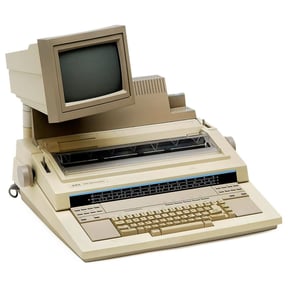A question we've run into many times with clients revolves around the paradigms of folders. We all know the model - we've lived with it for as long as offices have existed. Paper documents went into folders to group them, and then into drawers to create horizontal structure, and then filing cabinets to create a vertical structure. As we evolved into the digital age, system designers crafted experiences that mimicked this to instill a sense of familiarity.
 I remember being instantly at home with my first electronic document experience on a cutting-edge Xerox Memorywriter 6040 for this very reason. Even today, these digital systems have barely evolved at all - everyone drops documents into folders, nested within folders, nested within folders, ad infinitum. If you want to find board meeting minutes you locate the Administration folder, the Board Meetings folder in that, and then the Meeting Minutes folder within that. In essence, documents organized this way are described by their "location" rather than anything inherent to the document.
I remember being instantly at home with my first electronic document experience on a cutting-edge Xerox Memorywriter 6040 for this very reason. Even today, these digital systems have barely evolved at all - everyone drops documents into folders, nested within folders, nested within folders, ad infinitum. If you want to find board meeting minutes you locate the Administration folder, the Board Meetings folder in that, and then the Meeting Minutes folder within that. In essence, documents organized this way are described by their "location" rather than anything inherent to the document.
The problem is, this infinite folder model is actually wildly inefficient. People are forced to find content where the filer has placed it rather than how they might think of it. The initial solution to that was improving locational search, but over the last ten years, the design of expert content systems has evolved into raising metadata over the location. Today's document systems focus on enabling intrinsic (document type, size, name, etc.), deduced (Machine Learning analysis of content, context, etc.), and stated (assigned by the user) metadata. This information typically eliminates the need for folders entirely! Finally! We're free!
But wait... Now we've evolved past our own familiarity. As much as it is unquestionably easier to find content multidimensionally (based on how each user thinks of it) rather than in the 2D-space of folders, we've spent a century becoming adapted to our cabinets and drawers and now our digital folders. So we come full circle to the question of, "To Folder or Not to Folder?"
While factors such as use case, the users, and the culture of organizations play into the answer, we're leaning into a folderless future. Formal processes work especially well - albeit with a bit of getting used to. As an example, we recently deployed a large scale Contract Management solution where contracts are associated with deals, clients, and contacts (i.e. business objects, not folders). It's a better answer for classifying content, and it opens doors for users to find what they need in new ways.
TEAM IM has been delivering solutions and answers questions like this one for twenty years. As the market and technology have evolved, so have we. If you're curious, we can answer it for you too.
These Stories on Best Practices
1453 Helmo Ave N
Oakdale, MN 55128
L2, 1 Post Office Square
Wellington 6011
119 Willoughby Road
Crows Nest NSW 2065
No Comments Yet
Let us know what you think